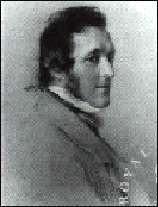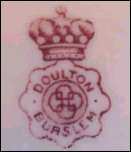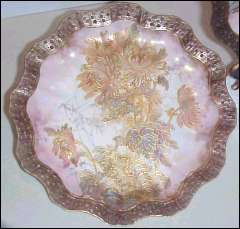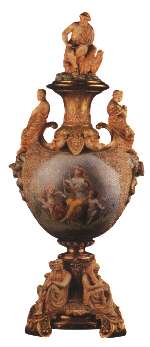John Doulton and his partner
John Watts established a pottery and porcelain in Lambeth, south London in
1815.
|

Henry Doulton |
Developed
by his son Henry Doulton, it became Britain's leading manufacturer of
sanitary wares and other industrial ceramics as well as a major producer
of art pottery and of ornamental and commemorative pieces, and tablewares.
In
1877, Doulton took over the Nile Street Burslem
factory of Pinder Bourne, where
tablewares and Art Pottery were being produced alongside industrial
ceramics. By 1882, this branch of Doulton's operation was making bone
china (porcelain containing bone ash). |
The
Lambeth Studio in London continued in existence until 1956, and since then
Doulton production has been concentrated at Burslem.
Having taken over many of its rivals both in industrial and decorative
wares, the Royal Doulton Group is now the largest manufacturer of ceramics
in Britain.

Back-Stamp from the
Burslem Works
|
John Doulton
In 1815, on the eve of Waterloo, John Doulton
was taken into partnership by the widow Martha Jones who had inherited from her
late husband a pottery in Vauxhall Walk, Lambeth, by the side of the Thames. Her
foreman John Watts was also taken into partnership and the firm became Jones,
Watts and Doulton.
The young Doulton was just out of apprenticeship with one of the most
important of the early commercial potteries of England, the Fulham manufactory
founded by the great John Dwight in the latter quarter of the 17th century,
where the making of stoneware in its true, vitrified form was brought to a
high degree of perfection. Thus began the long and distinguished history of
the Royal Doulton Potteries and it is not surprising that the earliest years
of the firm's existence were devoted to the making of articles ranging from
decorative bottles to drain-pipes in that very challenging of ceramic
materials, stone clay.
|
|
Henry Doulton
It was John Doulton's son, Henry, however, who carried that tradition of the
Lambeth pottery to its zenith.
By the time Queen Victoria came to the throne, Doulton was established as a
manufacturer of domestic and industrial products in a fine stoneware body that
bore comparison with any in Europe. Within the first ten years of Victoria's
reign, by 1846, the Lambeth factory was in the vanguard of the revolution in
sanitation which Chadwick and the great reformers of the day brought to
metropolitan England. Without the hard work and foresight of Henry Doulton
that revolution would have been best delayed by decades.
In 1882 Henry (later to be knighted by Queen Victoria, the first potter so
honoured), acquired the small factory of Pinder,
Bourne and Company at Burslem, mother town of the Staffordshire potteries
and, the home of that unique and essentially English ceramic body, bone china.
The incursion of the Lambeth
potter was looked upon with little enthusiasm or favour by the proud and
insular men of Staffordshire. "In their view we Southerners know little
about God and nothing at all about potting", observed Henry Doulton. |

The development of The Doulton Company
 The early relationship was uneasy and by no means profitable. But by shrewd
investment in men and plant he succeeded where more timid men would have
succumbed to local advice and given up the unequal struggle. Early commercial
success and artistic renown came to the factory through domestic and art wares
made in earthenware and decorated in the limited range of colours which that
body permits under its lead glaze.
The early relationship was uneasy and by no means profitable. But by shrewd
investment in men and plant he succeeded where more timid men would have
succumbed to local advice and given up the unequal struggle. Early commercial
success and artistic renown came to the factory through domestic and art wares
made in earthenware and decorated in the limited range of colours which that
body permits under its lead glaze.
But Doulton's brilliant young art director,
John Slater and his forceful and enterprising manager, John C. Bailey,
hankered after the colourful effects produced on the Continent by the on-glaze
enamel decoration of so-called faience, maiolica and delft wares; and on the
now popular porcelain body. They also sought the bone china body with which
near neighbours in Staffordshire were enjoying increasing success.
 |
 By 1884 they wrung from a reluctant Henry Doulton permission to use the new
body and to spread their artistic wings. Soon they were surrounded by one of
the most outstanding teams of modellers, decorators and painters in the world
of ceramics. The fame of the company and of its products became truly
international, and that fame was extended into the 20th century under a new
art director, Charles C. Noke, and through the talents of a brilliant
generation of artists who had grown to maturity under the old guard of the
Victorian period; Joseph Hancock, Harry Tittensor, Edward Birks, Percy Curnock
and others.
By 1884 they wrung from a reluctant Henry Doulton permission to use the new
body and to spread their artistic wings. Soon they were surrounded by one of
the most outstanding teams of modellers, decorators and painters in the world
of ceramics. The fame of the company and of its products became truly
international, and that fame was extended into the 20th century under a new
art director, Charles C. Noke, and through the talents of a brilliant
generation of artists who had grown to maturity under the old guard of the
Victorian period; Joseph Hancock, Harry Tittensor, Edward Birks, Percy Curnock
and others.
 In 1901 King Edward VII conferred on the company the double honour of the
royal warrant and the specific - as opposed to the assumed - right to use the
title "Royal". Along he way the honours were won at the great
international exhibitions at Chicago and Paris and the range of products
proliferated: the much sought-after Sung and Chang wares, and Rouge Flambe,
in those rare colour-effects which western potters had tried to simulate since
the dynastic wares of ancient China first found their way to Europe centuries
before; figures and character jugs reflecting the moods and fantasies of the
world around them; decorative and utility china, on earthenware and bone china
bodies, decorated both under the glaze and in a dazzling array on on-glaze
enamels.
In 1901 King Edward VII conferred on the company the double honour of the
royal warrant and the specific - as opposed to the assumed - right to use the
title "Royal". Along he way the honours were won at the great
international exhibitions at Chicago and Paris and the range of products
proliferated: the much sought-after Sung and Chang wares, and Rouge Flambe,
in those rare colour-effects which western potters had tried to simulate since
the dynastic wares of ancient China first found their way to Europe centuries
before; figures and character jugs reflecting the moods and fantasies of the
world around them; decorative and utility china, on earthenware and bone china
bodies, decorated both under the glaze and in a dazzling array on on-glaze
enamels.
|
| The inter-war years
 The
inter-war years saw the continued growth of the firm's product range, of its
renown and prosperity. In America, especially, the name Royal Doulton became
synonymous with the finest English china. By the conclusion of the second
world war, however, a new spirit was abroad. Simplicity became the watchword
in domestic furnishing and decoration; art, as practised by the great ceramic
painters of the past, began to give way to the concept of design; new
decorative and manufacturing techniques emerged to make fine china available
at a price that millions could afford where it had, hitherto, been the
preserve of the privileged. The
inter-war years saw the continued growth of the firm's product range, of its
renown and prosperity. In America, especially, the name Royal Doulton became
synonymous with the finest English china. By the conclusion of the second
world war, however, a new spirit was abroad. Simplicity became the watchword
in domestic furnishing and decoration; art, as practised by the great ceramic
painters of the past, began to give way to the concept of design; new
decorative and manufacturing techniques emerged to make fine china available
at a price that millions could afford where it had, hitherto, been the
preserve of the privileged.
 Jo
Ledger, a product of the modern school of designers, joined the company as its
new Art Director in the mid 1950's, and so another era began - an era in which
a healthy regard for past achievements and for the decorative traditions
associated with the finest of English tableware, bone china, was allied to the
fast-changing demands of the present. Jo
Ledger, a product of the modern school of designers, joined the company as its
new Art Director in the mid 1950's, and so another era began - an era in which
a healthy regard for past achievements and for the decorative traditions
associated with the finest of English tableware, bone china, was allied to the
fast-changing demands of the present.
|
Recent Developments
 In 1960 the company introduced a new product, English Translucent China,
developed over several years by research team led by Richard Bailey, who was
then Technical Director. By evolving his fine, translucent body while
eliminating the costly ingredient of calcined bone from the clay mix, Royal
Doulton was able to offer many of the qualities associated with the best bone
china to the world's markets at a relatively modest price.
In 1960 the company introduced a new product, English Translucent China,
developed over several years by research team led by Richard Bailey, who was
then Technical Director. By evolving his fine, translucent body while
eliminating the costly ingredient of calcined bone from the clay mix, Royal
Doulton was able to offer many of the qualities associated with the best bone
china to the world's markets at a relatively modest price.
 Now known simply as Royal Doulton Fine China, the new tableware has proved one
of the outstanding successes of the firm's long and eventful history. In 1966
it brought one of the first Queen's Awards for Technical Innovation to the
Doulton Company. Alongside these firmly established bone china and fine china
tableware ranges, has sprung a revival of Doulton Lambeth wares, motivated by
modern man's sympathy towards his natural environment. Royal Doulton's
Lambethware oven to tableware range captures the spirit of the present day in
a series of well-researched designs with a rural but progressive flavour.
Now known simply as Royal Doulton Fine China, the new tableware has proved one
of the outstanding successes of the firm's long and eventful history. In 1966
it brought one of the first Queen's Awards for Technical Innovation to the
Doulton Company. Alongside these firmly established bone china and fine china
tableware ranges, has sprung a revival of Doulton Lambeth wares, motivated by
modern man's sympathy towards his natural environment. Royal Doulton's
Lambethware oven to tableware range captures the spirit of the present day in
a series of well-researched designs with a rural but progressive flavour.
 The present day Lambethware range derives many practical advantages from its
rich inheritance. Its combination of tough, quartz-like compounds with
feldspathic Cornish stone gives it immense strength; a startling robustness of
appearance and feel. Modern ceramic technology adds refinement of glaze and
colour to those qualities, plus the essential characteristics of inherent
resistance to chemical attack and to extremes of heat and cold. The result is
a tableware range with a refreshing, country feeling whose keynote is
practicality; the entire range is oven and freezer proof and is unaffected by
detergent or dishwasher.
The present day Lambethware range derives many practical advantages from its
rich inheritance. Its combination of tough, quartz-like compounds with
feldspathic Cornish stone gives it immense strength; a startling robustness of
appearance and feel. Modern ceramic technology adds refinement of glaze and
colour to those qualities, plus the essential characteristics of inherent
resistance to chemical attack and to extremes of heat and cold. The result is
a tableware range with a refreshing, country feeling whose keynote is
practicality; the entire range is oven and freezer proof and is unaffected by
detergent or dishwasher.
In 2006 the firm of Royal Doulton were
taken over by the Waterford Wedgwood group.
 Identifying
marks on Doulton ware Identifying
marks on Doulton ware
 Doulton's own
Internet site: www.royal-doulton.com Doulton's own
Internet site: www.royal-doulton.com |